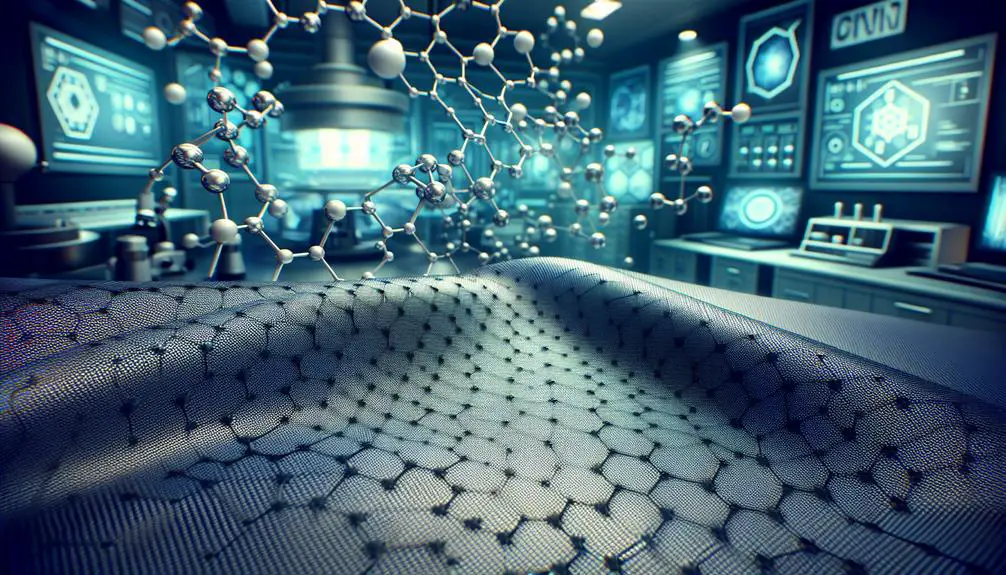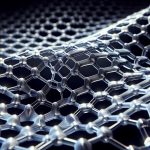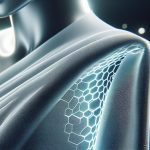You've probably heard the buzz around graphene and its potential to transform various industries, but have you ever considered its impact on the fabrics you wear? Graphene-enhanced fabrics combine unmatched durability, exceptional thermal regulation, and energy efficiency, making them a game-changer in textile manufacturing. Imagine apparel that's not only tough but also eco-friendly and highly functional. How exactly do these fabrics achieve such remarkable properties, and what does that mean for the future of clothing? Let's explore the fascinating world of graphene and discover why it's poised to revolutionize your wardrobe.
Table of Contents
Key Takeaways
- Graphene fabrics offer enhanced durability, strength, and wear resistance, ensuring longevity even after extensive use.
- They provide superior thermal regulation with efficient heat distribution and moisture management, adapting to body needs.
- The integration of graphene in textiles allows for smart fabrics that can monitor health, regulate temperature, and power devices.
- Manufacturing challenges include maintaining consistent high-quality graphene supply and eco-friendly production methods while reducing costs.
- Future innovations in graphene fabrics promise sustainability benefits, such as less frequent washing and multifunctional garments.
What Is Graphene?
Graphene, a single layer of carbon atoms arranged in a hexagonal lattice, is renowned for its remarkable strength and conductivity. You might be wondering what makes this material so special. Its unique structure endows it with exceptional material properties, including a tensile strength over 100 times greater than steel and an electrical conductivity superior to copper. These properties make graphene ideal for a wide array of applications.
In everyday life, graphene applications are expanding rapidly. It can be found enhancing the performance of electronic devices, improving battery life and efficiency, and even revolutionizing medical sensors. Its unparalleled conductivity makes it a prime candidate for use in flexible and wearable electronics, pushing the boundaries of what's possible in tech design.
Moreover, graphene's properties aren't limited to just electronics. Its potential in water filtration, due to its impermeability to most substances, is groundbreaking. The material properties of graphene also make it an excellent additive in composite materials, increasing their strength and durability without adding significant weight.
Mastering the basics of graphene allows you to appreciate its transformative impact across various industries. With continued research and development, the potential applications of this extraordinary material are virtually limitless.
Benefits of Graphene Fabrics
You'll find graphene fabrics offer impressive benefits, including enhanced durability and strength. These fabrics resist wear and tear much better than traditional materials.
Additionally, they provide superior thermal regulation, keeping you comfortable in various temperatures.
Enhanced Durability and Strength
Imagine a fabric that doesn't just look good but also withstands the wear and tear of daily use much better than traditional materials. With graphene-enhanced fabrics, you're stepping into a domain of wearable technology that truly leverages graphene innovation. This cutting-edge material imbues textiles with unparalleled durability and strength, ensuring your garments remain intact and functional even under rigorous conditions.
Graphene's remarkable properties make it indispensable for sustainable textiles. Its integration into fabrics not only extends their lifespan but also reduces the need for frequent replacements, contributing to more eco-friendly consumption. This means less waste and a smaller environmental footprint—an essential consideration in today's world.
Moreover, graphene applications in fabrics enhance their overall resilience. Whether you're an athlete needing robust sportswear or a professional seeking long-lasting work attire, graphene-enhanced materials rise to the occasion. They offer superior tensile strength and resistance to abrasion, elevating the performance of everyday apparel.
Superior Thermal Regulation
Beyond enhancing durability and strength, graphene-infused fabrics also offer superior thermal regulation, keeping you comfortable in varying temperatures. Imagine clothing that adapts to your body's needs, maintaining ideal temperature by dissipating heat in warm environments and retaining it when it's cold. This adaptability ensures you stay comfortable without the need for multiple layers or frequent adjustments.
Graphene's exceptional thermal conductivity plays a pivotal role in this, allowing for efficient heat distribution across the fabric. This not only enhances your comfort but also contributes to effective moisture management. By wicking away sweat and dispersing heat, graphene-infused fabrics prevent clamminess and overheating, ensuring you remain dry and comfortable.
Moreover, these advanced fabrics promote energy efficiency and sustainability. By reducing the need for artificial heating or cooling, you minimize your reliance on energy-consuming appliances, which translates to lower energy bills and a smaller carbon footprint. This makes graphene-enhanced fabrics an environmentally conscious choice.
Incorporating graphene into your wardrobe means embracing cutting-edge technology designed to improve your daily life. You'll experience unparalleled comfort, superior performance, and the added benefit of contributing to a more sustainable future. Choose graphene-enhanced fabrics, and master the art of dressing intelligently and sustainably.
How Graphene Fabrics Are Made
You'll find that creating graphene fabrics involves a precise graphene coating process and advanced fabric integration techniques. These methods guarantee the graphene adheres well and enhances the fabric's properties.
However, production challenges can arise, particularly in maintaining consistency and scalability.
Graphene Coating Process
To create graphene-enhanced fabrics, manufacturers start by applying a thin layer of graphene oxide onto the textile surface. This initial step in the process involves various coating techniques to ensure uniform graphene application. One popular method is dip coating, where the fabric is immersed in a graphene oxide solution, guaranteeing that the graphene adheres evenly.
Another technique is spray coating, which allows for precise control over the amount of graphene applied, making it ideal for specialized fabric enhancements.
Once the graphene oxide layer is applied, the fabric undergoes surface modification to improve its properties. Reduction treatments, often involving chemical or thermal processes, convert graphene oxide into reduced graphene oxide, enhancing conductivity and strength. This transformation is essential for fabric enhancement, as it maximizes the beneficial properties of graphene.
After the surface modification, the treated fabric exhibits improved characteristics such as increased durability, conductivity, and even antibacterial properties. These enhancements make graphene-coated fabrics ideal for various applications, from high-tech sportswear to advanced medical textiles.
Fabric Integration Techniques
Integrating graphene into fabrics involves advanced techniques that guarantee the material's unique properties are seamlessly embedded into the textile. One primary method is innovative weaving. In this technique, graphene is interlaced directly with the fabric fibers, ensuring that the exceptional strength and conductivity of graphene are distributed uniformly throughout the textile. This method not only enhances the fabric's durability but also maintains its flexibility and breathability.
Another critical technique is advanced bonding. By using advanced bonding methods, you can attach graphene particles to fabric surfaces without compromising the material's integrity. This process involves applying a graphene dispersion onto the fabric, followed by a curing phase that secures a strong, permanent bond between the graphene and textile fibers. The result is a fabric that retains the lightweight, soft characteristics of traditional textiles while gaining the extraordinary properties of graphene, such as thermal regulation and enhanced mechanical strength.
Understanding these integration techniques allows you to appreciate the complexity and ingenuity involved in creating graphene-enhanced fabrics. By mastering these methods, manufacturers can produce textiles that push the boundaries of performance, catering to various high-demand applications like sportswear, medical textiles, and protective clothing.
Production Challenges
Mastering these integration techniques is just the beginning; the real challenge lies in scaling up production while maintaining the quality and properties of graphene-enhanced fabrics. You need to navigate several hurdles, from guaranteeing a reliable supply chain to meeting sustainability goals. Cost efficiency and scalability are key factors that can make or break your efforts.
To give you a clearer picture, here's a breakdown of the major production challenges:
| Challenge | Description | Impact |
|---|---|---|
| Supply Chain | Securing a consistent supply of high-quality graphene | Affects material consistency |
| Sustainability | Embracing eco-friendly production methods | Enhances brand reputation |
| Cost Efficiency | Reducing production costs while preserving quality | Essential for market viability |
| Scalability | Expanding production capacity without compromising on fabric properties | Critical for meeting demand |
| Quality Control | Ensuring even graphene dispersion and fabric performance | Maintains product standards |
Each of these challenges requires targeted strategies. For instance, optimizing your supply chain guarantees you have consistent material quality. Implementing sustainable practices not only helps the environment but also appeals to eco-conscious consumers. Balancing cost efficiency with high-quality production is essential for profitability. Lastly, scalability ensures you can meet market demands without sacrificing quality.
Durability and Strength
Graphene-boosted fabrics are transforming the textile industry with their exceptional durability and strength. By incorporating graphene into the fiber properties of textiles, manufacturers have achieved unparalleled levels of innovation. This remarkable material greatly enhances the wear resistance and longevity of fabrics, making them ideal for demanding applications. You'll notice that these advanced textiles maintain their integrity even after extensive use, ensuring that garments remain in excellent condition for longer periods.
In the field of wearable technology, graphene-boosted fabrics stand out due to their superior performance. These fabrics aren't only strong but also incredibly flexible, allowing for a wide range of motion without compromising durability. Whether you're an athlete pushing the limits or someone seeking reliable everyday wear, the enhanced strength of graphene-infused textiles ensures that your clothing can withstand the challenges of any activity.
Furthermore, the innovation doesn't stop there. The incorporation of graphene into fabrics opens up new possibilities for high-performance gear. Lightweight yet resilient, these materials can significantly enhance the quality and functionality of sportswear, workwear, and even fashion items.
Embrace the future of textiles with graphene-boosted fabrics and experience the peak of durability and strength.
Thermal Regulation
Not only do graphene-boosted fabrics offer remarkable durability, but they also excel in thermal control, keeping you comfortable in a wide range of temperatures. These advanced textiles are designed to adapt to your body's needs, providing both heat retention and breathability.
When it's cold, the graphene-infused fibers act as an excellent insulation layer, trapping body heat to keep you warm. Conversely, in warmer conditions, the fabric's moisture-wicking properties come into play, efficiently drawing sweat away from your skin and enhancing breathability.
Graphene's unique thermal conductivity ensures that your body heat is evenly distributed across the fabric, preventing hotspots and maintaining a consistent temperature. This balance between insulation and moisture wicking makes graphene-enhanced fabrics ideal for a variety of activities, from intense workouts to casual outings.
You'll appreciate how the fabric adapts to your body's thermal needs, guaranteeing maximum comfort regardless of the external conditions.
Moreover, the breathability of these fabrics is unmatched, allowing air to circulate freely, which is essential for maintaining comfort during prolonged wear. With graphene-enhanced fabrics, you won't have to compromise on thermal control, no matter the season or activity.
Tech Integration
Incorporating smart technology into graphene-enhanced fabrics opens up a world of possibilities for interactive and responsive clothing. Imagine wearing a jacket that not only keeps you warm but also charges your phone. The fusion of wearable technology with graphene fabrics is revolutionizing the fashion industry, creating garments that aren't just stylish but also highly functional.
Graphene's unique properties make it an ideal candidate for smart textiles. You're looking at fabrics that can monitor essential signs, adjust to environmental conditions, and even power electronic devices. This integration aligns perfectly with current sustainability trends, as graphene's durability and efficiency reduce waste and energy consumption.
Consider these game-changing applications:
- Health Monitoring: Track your heart rate, temperature, and other crucial signs seamlessly.
- Energy Efficiency: Charge your devices on the go without carrying extra gadgets.
- Adaptive Comfort: Fabrics that adjust their thermal properties based on the weather.
- Enhanced Durability: Longer-lasting garments that withstand wear and tear.
- Eco-Friendly: Reduced environmental impact thanks to graphene's sustainable features.
Future of Graphene Fabrics
Looking ahead, the future of graphene fabrics promises innovations that could reshape the textile industry. With graphene's remarkable properties, you'll see a significant sustainability impact. These fabrics are more durable and require less frequent washing, which reduces water and energy consumption. This aligns perfectly with the increasing demand for eco-friendly products.
Fashion trends are also set to evolve. Designers are already experimenting with graphene's unique abilities, such as its conductivity and strength, to create cutting-edge, functional garments. Imagine clothes that can regulate temperature, monitor health, or even charge your devices. These advancements won't only push the boundaries of fashion but also introduce a new era of smart clothing.
Consumer adoption is poised to rise as awareness and availability increase. Early adopters are already reaping the benefits, and as production scales up, costs will come down, making graphene-enhanced fabrics more accessible. Market growth in this sector is inevitable, driven by the convergence of technology and fashion.
In essence, the future of graphene fabrics is bright, holding the potential to revolutionize how we think about clothing—from sustainability and fashion trends to consumer adoption and market growth. Your wardrobe might never be the same again.
Frequently Asked Questions
Are Graphene-Enhanced Fabrics Eco-Friendly and Sustainable?
Graphene-enhanced fabrics can be eco-friendly due to their longevity, reducing waste. However, the environmental impact depends on the production process. If the process is sustainable and recyclability is guaranteed, then they're a greener choice.
How Should I Care for My Graphene-Enhanced Clothing?
To care for your graphene-enhanced clothing, follow specific washing instructions to promote longevity. Use cold water and mild detergent. For storage tips and maintenance, keep items in a cool, dry place, avoiding direct sunlight.
What Is the Cost Difference Between Graphene Fabrics and Traditional Fabrics?
You might think you're paying for threads spun by golden spiders. Graphene fabrics have higher production costs, but their long-term durability could save you money over time. Traditional fabrics are cheaper upfront but might wear out quicker.
Can Graphene Fabrics Cause Skin Irritation or Allergies?
You won't need to worry much about skin reactions with graphene garments. The fabric comfort and graphene safety are well-researched, ensuring minimal issues. However, if you have sensitive skin, always test for any potential irritation.
Are There Any Specific Brands Known for High-Quality Graphene-Enhanced Garments?
Think of popular brands like the North Face and Vollebak as pioneers, tackling the innovation challenges of graphene fabrics. They offer performance benefits, setting market trends with cutting-edge, high-quality garments that enhance your adventures.
- How Does Ring Spun Cotton Affect Garment Fit and Shape Retention? - August 13, 2024
- What Are the Challenges in Producing Ring Spun Cotton? - August 13, 2024
- Is Ring Spun Cotton Suitable for Plus-Size Clothing? - August 13, 2024







